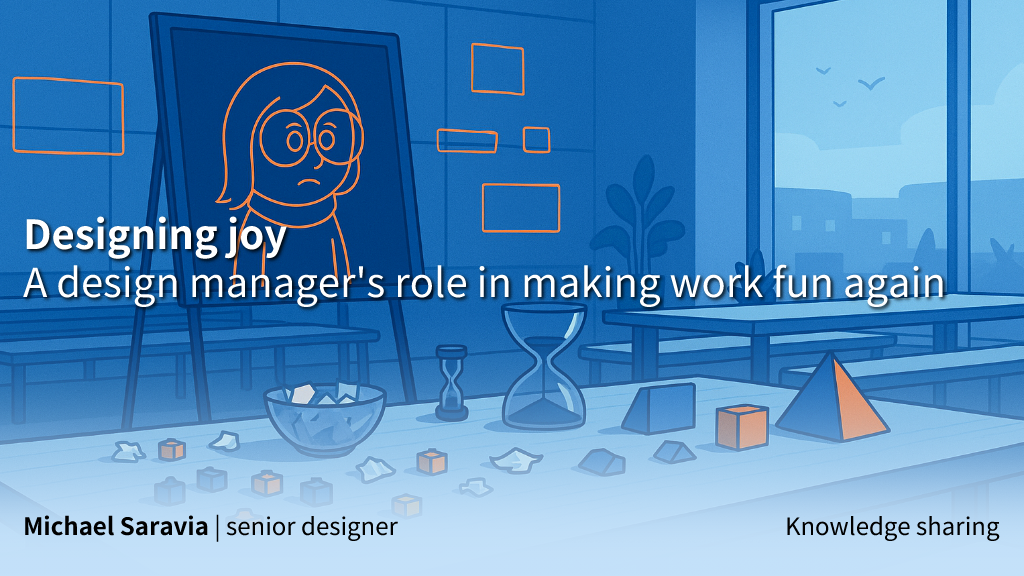
Over a quiet 1:1 with my own manager one morning, we got into a surprisingly energising conversation about what really makes a team thrive. Not survive, but actually thrive. While we can’t control market downturns, restructuring, or sudden strategy pivots, we can influence something just as powerful: how our team feels during the hours they give us each day.
This article is for design managers who want to create not just a productive, but also joyful and mentally healthy culture for both the team and the individuals within it. Here are the mindset shifts and rituals I’ve found most effective and a few practical examples you can adapt.
The energy gap between deadlines
We all know how easy it is for weeks to blur into a mix of Zoom calls and Figma comments. Team-building events once a quarter sound nice on paper, but what about the other 89 days? If your team only laughs together once a quarter, it’s no wonder many end their week burnt out.
I started experimenting with smaller, recurring activities: 30-minute pictionary matches (we are designers after all), casual walks talking about an exciting show or movie, or LEGO building breaks with a theme in mind. Nothing too grand, but enough to break the “always-on” rhythm and let people connect as humans. These regular touchpoints give space to recover from the mental tax of problem-solving. They also help colleagues see one another in a different light, which boosts collaboration.
From goal-setting to goal-guiding
When it came time for performance conversations, I realised many team members struggled with setting exciting or joyful personal development goals. Not because they lacked ambition, but because they hadn’t been taught how to articulate what really drives them.
That’s when I came across the concept of a cardinal direction. The term itself has roots in philosophy, from the Latin cardo, meaning “hinge.” Cardinal virtues, as described by thinkers like Plato and Aquinas, were considered foundational qualities that all other virtues turned upon. That metaphor stuck with me. In the context of design careers, a cardinal direction isn’t a fixed end goal, but a guiding orientation, grounded in your values, the environments you thrive in, and the impact you hope to create. Unlike rigid goals, your cardinal direction evolves with you, helping you prioritise projects and shape opportunities with more purpose.
As a manager, I stopped treating career goals as a solo homework assignment and instead turned them into a collaborative reflection. I began asking questions like:
- What kind of work energises you?
- What do you want to be known for in the next 2 years?
- What does a great day at work feel like for you?
The purpose isn’t to lock people into one rigid path but to encourage them to keep tuning into what gives their work meaning.
The human side of leadership
We spend a lot of time trying to be good mentors, coaches, and delivery leads, but how often do we think about being a good vibe setter?
A design manager’s impact goes beyond career ladders and sprint boards. We shape emotional culture, the unspoken tone that defines whether your team ends the day feeling drained or fulfilled. That doesn’t mean putting on forced positivity or making fun mandatory. It means showing up with curiosity, creating psychological safety, and making space to celebrate small wins, not just OKRs.
And it also means being available. When a teammate asks for guidance on their goals or signals they’re feeling overwhelmed, be ready to listen and suggest without defaulting to “You’ve got this — I trust your instincts”. Leadership isn’t about having all the answers, but being the kind of person others trust to help them ask the right questions.
What if fun was part of the job?
Big companies like Pixar have long recognised that creative risk-taking requires play. It’s not just a perk, it’s infrastructure. Weekly art sessions, silly internal competitions, even the occasional mean caricature night. Because they know that looseness in the day helps spark something later at the desk.
You don’t need to copy-paste what others do. But you do need to ask: what feels meaningful and energising for this team, right now? It could be storytelling lunches. It could be collective journaling. It could be skipping all of it and just leaving early once in a while.
What matters most is intention. That you design not only your product, but also your team’s experience of work. Because ultimately, the strongest products come from the healthiest, most connected teams.
Final reflection:
One thing I always tell my team, and remind myself of often is this: if something inside you is uneasy, pay attention. The way a manager responds to your questions or dismisses your need for clarity says a lot. If you’re a manager, take note: silence or impatience can become culture by default. Be the person who shows up. Fun isn’t a side dish to good work. It’s a sign of a well-fed team.
Would love to hear how you’ve made work feel more human and fun. Reach out anytime on LinkedIn or drop me a note through the contact form. Let’s design better, together.